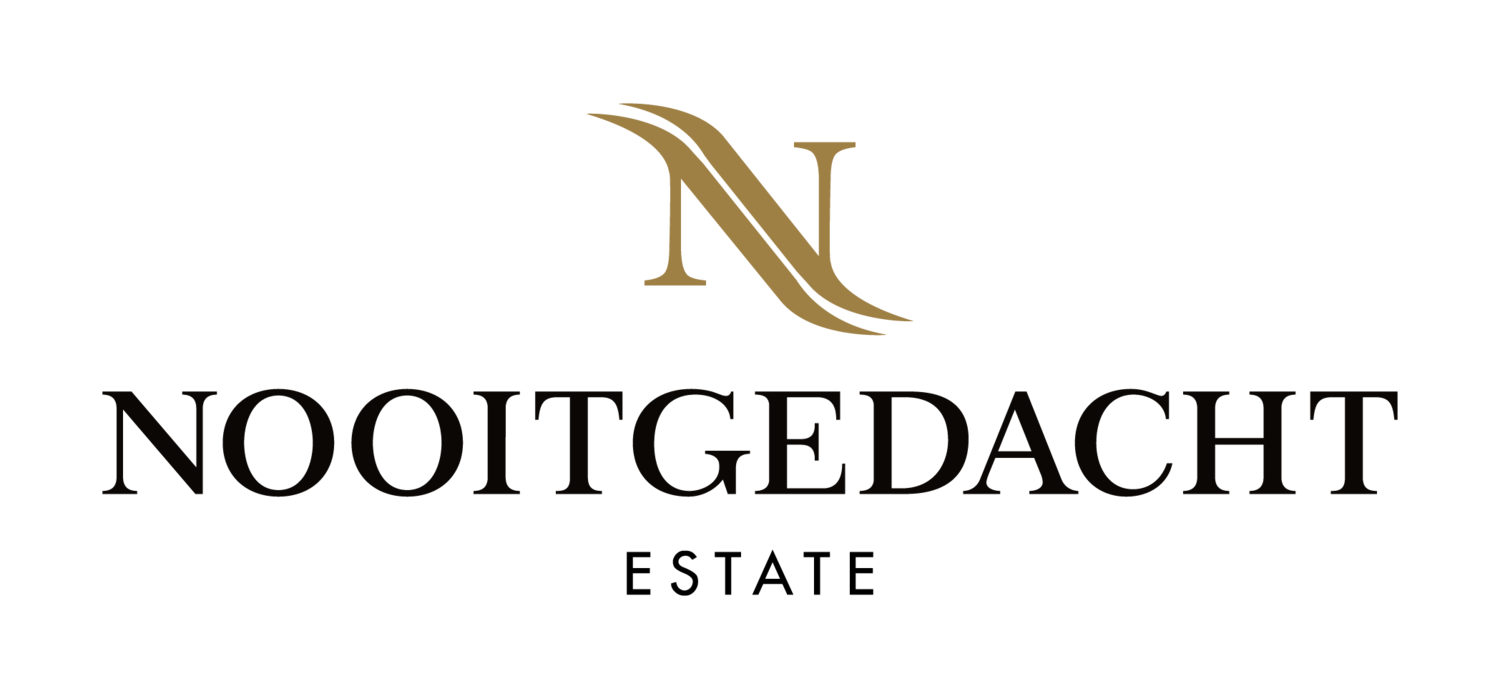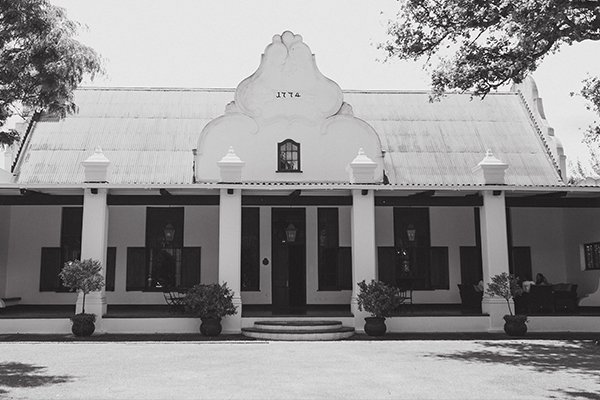
About Nooitgedacht Estate
A homestead through the ages since 1774
Our Speciality
Leave us to do what we do, best, so that you can focus on the moment of your wedding or function.
Steeped in History
In 1692, a fine piece of land in the Stellenbosch Winelands was granted to a blacksmith from Magdeburg, Germany.
Doing what we do, best
With its historic charm and Cape Dutch roots, Nooitgedacht Estate is fondly known as one of the best venues in the Stellenbosch area for weddings, events, a range of experiences and corporate events.
Our estate boasts expansive lawns, shaded by century-old oak trees, rolling vineyards, a historic 18th-century manor house and outbuildings and exhibiting an authentic old-world vibe.
The Wirth family pride themselves on adding a personal touch to each event they host, which can be found in every aspect of the service offering. All aspects of the event preparation, down to the last immaculate detail, are tailored to suit your individual needs to ensure that your function is a truly unique and special occasion.
Our history
Matthias Greeff had been living on the farm for ten years when the title deed with the name “Nooitgedacht” was handed over to him by Nooitgedacht VillageSimon van der Stel – the founder of Stellenbosch.
Greeff became a prominent figure in the young Stellenbosch community: he was a well-known sheep farmer, Heemraad of Stellenbosch and served as corporal in the Citizen Force.
He also trained himself in the field of herbal medicine, which, after refining his knowledge and skills, he made available to the local community.
1718 The Cloetes of Nooitgedacht
In 1718 Nooitgedacht was purchased by Johannes Albertus Loubser, who was married to Sibella Passman. After her husband’s death, Sibella married Jacob Cloete, the grandson of Jacob Cloete, who was one of the first free burghers in 1657. Sibella herself was also a notable figure, having bought Weltevreden and Hartenberg. The Cloete-Passman crest can be found in the Moederkerk in Stellenbosch to this day.
Jacob and Sibella’s son, Hendrik, inherited the farm in the latter half of the 18th century. He proved to be a very capable farmer and planted many vineyards. In 1769 he also built the slave bell, and in 1774 the H-form Herehuis. This is the date engraved on the facade. He bought numerous farms and became known as one of the wealthiest individuals in the region. In 1778 he bought Groot Constantia – property of Van der Stel at the time. He then moved here, leaving Nooitgedacht to Johan Gerhard Cloete – one of his 11 sons.
After the death of his wife, Hester, Hendrik moved back to Nooitgedacht, where he died in 1799. It is apparent that Hendrik entertained many visitors at Nooitgedacht. Petrus Borchardus Borchers, the son of a local pastor, paid tribute to Hendrik’s hospitality. He writes that “he had his sportsman supplying the table with game and fish, a large poultry yard and pigeon-house [and] a box with eels…”
The farm remained the property of the Cloete family until Michael Ackerman bought it in 1844. Five years later the farm was sold to Jan Martinus Beyers. A descendant of Jan Beyers, Beyers Truter bought Beyerskloof, which historically formed part of Nooitgedacht. He is widely considered to have put the cultivar Pinotage on the international map.
Cecil John Rhodes
A photograph taken in 1923 of the 18th century Nooitgedacht homestead.
Sibella Passman
1892 Rhodes abides in the Boland
The phylloxera plague, which threatened the future of the South African winemaking industry, hit in 1892. The Rhodes Trust (later known as Rhodes Fruit Farms Ltd.) subsequently bought multiple farms in the region, in order to prove that fruit farming could flourish here – even as well as winemaking had done. He assigned the task to a young Englishman, H. E. V. Pickstone. Pickstone’s orders were to find farms suitable for fruit farming. Those with beautiful old farmhouses were to enjoy preference. Nooitgedacht was chosen, along with Boschendal, Rhone, Vredenburg, Bien Doné and Lekkerwyn, among others. When it came to choosing a farm as his personal abode, Rhodes chose none other than Nooitgedacht. Many of the structures found at Nooitgedacht today were restored or built at this time.
1901 Hooves and Helmets
During the South African War (1899 - 1902), Nooitgedacht was used by the British government as a remount camp. At certain stages of the war, Stellenbosch received as many as 1400 horses every day, many of which would be received at Nooitgedacht, where tents and sheds had been erected for this purpose.
Many soldiers were buried on the farm, but only one grave remains to this day. Buttons from uniforms, buckles, coins and other objects from this era have been found in the latter years, and are displayed in the display cabinet in the manor house.
The original title deed from Simon van der Stel.
The Manor House still maintains its original form since its establishment.
A photograph of Fritz Wirth’s meeting with the Portuguese King.
1923 The Wirth era begins
1923 marks the year when the Wirth-family story became intertwined with that of the Nooitgedacht farm. How the family made their way to the Southern tip of Africa is an epic tale in itself.
After severe losses on the stock market and personal crises, a cigar-factory owner from Hanover, Germany, Hermann Albert Ludwig Wirth, took his family in search of more favourable fortunes on foreign soil. In 1880 the family left for South Africa on board a steamship called the “American”. The ship, however, sank having hardly reached the equator. They were stranded on the West coast of Africa for almost 4 months until a passing merchant ship rescued them and took them back to South Hampton, England. Not letting adversity get them down, and being determined to reach Southern Africa to start their new life, they took the first available ship back to South Africa. The Wirth’s ended up settling in Delagoa Bay (more recently known as Lourenço Marques and today as Maputo) in modern-day Mozambique – where they bought the Century hotel. Their son Fritz joined a commercial import and export firm, which was renamed Breyner & Wirth after he became a partner.
Fritz Otto Robert Wirth became involved in trade negotiations between Portugal and South Africa and was often sent to Portugal to conduct these. He spoke 10 languages and was Consul General for various countries including China and formed close bonds with luminaries and statesmen such as the Portuguese King, the Chinese Emperor, Paul Kruger, Jan Smuts and Ernst Oppenheimer.
After his retirement, he and his sister, Louise, bought the Nooitgedacht farm as their retirement residence in 1923. Fritz Otto Robert Wirth passed away in 1940, leaving Nooitgedacht to Louise. After the death of Louise, the farm was placed in trust for Fritz Wirth, the only son of Hermiene Louise (Milu) Wirth.
Milu grew up to be a capable farmer who did not seem to stand back for anything. Her being the only female member of the Stellenbosch Gentlemen’s Club, established by Distell founder Bill Winshaw, was one indication of her peculiar resilience.
In 1973 Fritz took over the farming responsibilities from his mother and bought back 38ha of farmland that used form part of Nooitgedacht. Later, he bought the 50 Ha farm Kriekbult from Kanonkop.
1989
In 1989, Fritz bought the 25ha piece of land where Nooitgedacht Village is today from Tongaat Hulett. He started the process of rezoning and chaired the Koelenhof water association to get water to the area from the Wemmershoek Dam. He also installed the sewerage line from Koelenhof to Stellenbosch and the bulk services for the estate.
The Wirth Family
An interior view of the Manor House













